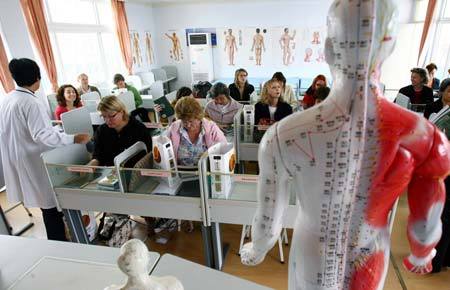VIII-7 Question: Nature cures and herbal medicine are all the rage in today's world, a fact that creates a good opportunity for the promotion of Chinese traditional medicine (CTM). What should be factored into the promotional aspects, and what would China be expected to do to accelerate CTM's entry into the global market?
A: China, as the cradle of CTM for thousands of years in history, yields not only natural plant cures, but also effective recipes, making it a rich reserve of CTM both theoretically and practically. Since there are certain medical difficulties that are still confounding Western doctors, who're still debating cures, CTM is playing an increasingly crucial role in handling these difficult diseases and has raised a surge of popularity in natural and herbal medicines throughout the world.
Despite a dramatically increasing demand for it, CTM accounts for merely 5 percent of the world's total pharmaceutical market. Besides lack of cultural recognition, CTM has primitive manufacturing R&D, which leads to inadequate data supporting its usage safety, quality control and effectiveness. In addition to scarce experimental data and bad packaging, Chinese herbal medicine is recommended only as a nutritious food or used as additives in most European countries. A majority of Chinese herbalists are not even certified doctors, in foreign countries.
In order to raise the quality of CTM and boost promotion, the Chinese Government is drafting an industrial plan on how to modernize traditional medicines, in which four major tasks have been set: developing new herbal medicines catering for international market demands, setup of a modern R&D system, the establishment of a hi-tech oriented medicine industry, and the promotion of Chinese herbal medicine entry into the global market. At the same time, China's drug and food watchdog has carried out a four-year plan concerning the standardization of CTMs. At present, this is aimed more at tighter quality control over clinics, institutes, raw medicines and certification of CTM doctors. Also, translation of the medical terms of CTM is more regulated, and a standardized test will be initiated to certify qualified doctors and pharmacists worldwide.
Meanwhile, the government will seek more cooperative international partners, official or non-governmental, for optimization of its CTM resources. By 2007, the first cooperative plan on hi-tech development of CTM will be started, in which six aspects will be emphasized, including the prevention and treatment of neurotic symptoms, cardiovascular diseases, tumors and AIDS. Efforts on the expansion of international market shares will also be made by developing new herbal medicines, and setting up joint-venture research centers and laboratories with foreign partners. A global network will take shape by 2020 with five to 10 clinical institutes, labs and research centers involved. Therapeutic effectiveness evaluation and usage dose of a hundred herbal medicines, R&D of new products, as well as clinical research on the top 10 most favorable medicines is scheduled for development through efforts of this network.
So far, China has governmental pacts with 70 countries and regions with respect to CTM cooperation. Chinese herbalists have been recognized and protected in Australia and South Africa. CTM exports have been extended to 135 countries and regions, and even registered as certified drugs in some countries.

(China.org.cn)